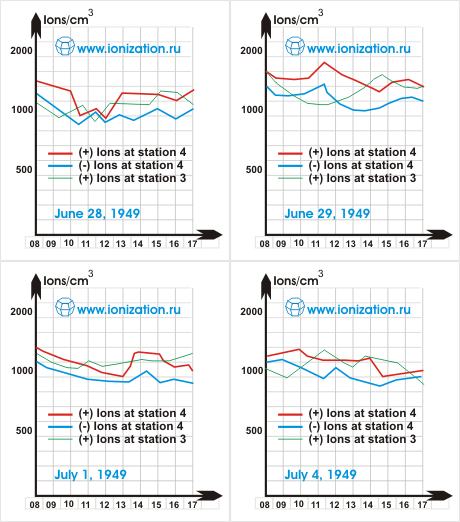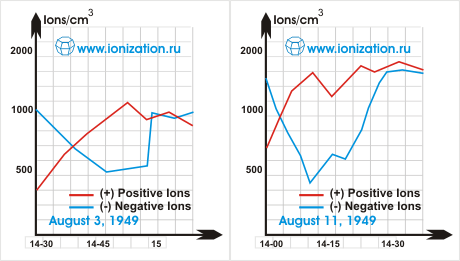We found out the correlation between the variations of ions density and definite meteorological factors during the winter period. The same conclusions were made in summer measurements.
A. Correlation with wind.
The highest density of ions or at least the increase of ions density was observed at NW, NNW (i.e. from the continent to Atlantic). However, sometimes the density of ions did not change even with NW, NNW wind. In such cases the humidity had a great importance. In general we can say that the density of ions increases with NW, NNW wind or when the direction of wind changes to NW, NNW.
B. Correlation with rain.
As it was expected the rain decreases the density of ions. At all periods of rainy weather we observed the decrease of ion density. It is important to notice that the density of negative ions exceeds the density of positive ions during rains. Probably, these increases are similar to variations that were observed in December and the formation of negative charged in pulverized water could explain that fact.
C. Correlation with humidity.
During winter observations there was determined the correlation between the changes of ion density and relative humidity. At low values of relative humidity the density of ions was high. It was useless to check this correlation at summer measurements. In sunny summer days the relative humidity changes systematically and the minimum value is between 12 and 2PM. It is connected with the increase of temperature at these hours. As it is shown on a picture the changes of ion density do not have systematic day variations. But we can determine the correlation between the density variations and the relative humidity changes. Not the absolute values of absolute humidity but its changes can be connected to the ion density. We can have the same absolute values of absolute humidity but different densities of ions. However, with the change of absolute humidity the density of ions can also change. So, during the first hours of a day the absolute humidity changed for all extremely high ions density values. At NW, NNW directions of wind the density of ions did not essentially change. Than, with the increase of ion density the absolute humidity increased. In winter the changes of absolute humidity are equal to changes of relative humidity and that is why during the winter measurements we cannot judge the role of absolute humidity changes, because, as it was said before, the absolute humidity itself is not connected to the variations of ion density.
D. Conclusion.
Summing all up we can suppose that variations of ion density depending on meteorological conditions are caused by two factors:
- Transportation of air masses with high density of ions by NW and NNW winds, which go over large territories where the radioactivity of the ground adds new ions.
- Change of absolute humidity. In the present situation with the increase of absolute humidity there is very low probability of small ions transformation into large ones and the density of small ions increases. However, with the increase of absolute humidity the process of large ions formation can be preferable and the density of ions lowers. Sometimes there can be differences of absolute humidity values in places of observation and in values of absolute humidity measured in Meteorological Institute what causes the declination of data from the indicated rules.
Parallel measurements.

Parallel measurements were made on 3rd and 4th stations from 26th of June up to 4th of July 1949. In general these results matched the results got in winter. Some results of ion density variations are represented on pictures 1-4. as a rule, the density of ions was higher.
Variations of ion density, which are caused by thunderstorm.
During the systematic observations in summer 1949 there were no thunderstorms above the observation place. But sometimes the thunderstorm region came close and there were made measurements on station 4. In spite of the fact that there were no any thunderstorms above the place of observation there were made some episodic measurements and in cases when the thunderstorm was at some distance from the observation place, there were marked some specific variations of ion density.

On the 3rd of August there was indicated a thunderstorm in notes of Meteorological Institute at 1.50PM in the SW; at 1.58PM in the S; at 2.05PM in the SE and at 2.12PM, 2.16PM, 2.23PM. The results of our measurements, which began at 2.33PM, were represented on picture 5 and we can see there the decrease of negative ion density from 1050/cm3 to 500/cm3 in more than 20 minutes. In the next 5-8 minutes the density achieved its normal value - more than 1000 ions per cm3. On the other side the density of positive ions, which was less than 500 ions per cm3 in the beginning of measurements, increased in 20 minutes up to normal value - 1000 ions per cm3. While measurements it was raining and there were S and SE winds.
The same effect was observed on the 11th of August. For this day the thunderstorm was registered at 1.02PM in the SW; 1.08PM in the SW; 1.15PM in the SSE; 1.16PM in the N and NW; 1.21PM in the N; 1.23PM in the NNE; 1.24PM in the SE; 1.33PM in the E; 1.36 PM in the NW and E; 1.39 PM in the ENE; 1.45PM in the NE; 2.15 PM in the NE; 2.17PM in the E.
The results of our measurements showed the decrease of negative ion density from 1400/cm3 up to 250/cm3 in 12 minutes; in the following 15 minutes it achieved 1650/cm3. At the same time the density of positive ions, which was 750/cm3 in the beginning, in some time achieved the value of 1000/cm3. During the period of observations up to 2.10PM it was raining and there was the WSW wind.
Conclusions.
- Changes of characteristics of small ion density variations, which were made in 1948 during the time of winter solstice, were continued in 1949 during the time of summer solstice.
- Variations of ion densities were observed steadily during 13 days.
- Usually the density of ions is higher in summer in comparison with winter.
- The amplitude of ion density variations during summer is higher than during winter.
- There can be made a correlation between the variations of small ion density, direction of wind and changes of absolute humidity.
- The results of parallel measurements on two stations match with results that were got earlier.
- When there was the thunderstorm region along the place of observation there was registered the decrease of density of negative ions during 15-20 minutes and the reversion to norm was gradual. The density of positive ions also decreased but the reversion process was quicker.
The article is composed and developed by A. Tuktagulov (www.ionization.ru) from the materials of Uppsala University
FULL OR PARTIAL CITING OF THE ARTICLE IS FORBIDDEN




